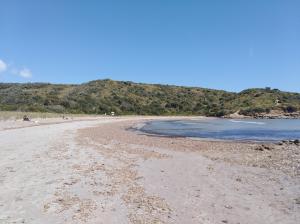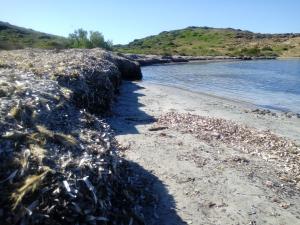Life’s a Beach
Often referred to as the ‘lungs of the ocean’, Posidonia is an intrinsic part of healthy marine and coastal habitats. Both alive and dead, the marine plant helps to sustain life, filters and oxygenates the water, absorbs more CO2 per year than trees, and helps stabilize beaches making this sea plant essential for life above and below water.
*
Posidonia oceanica, the sea grass native to the Mediterranean, is currently in huge decline due to years of destructive fishing and free-mooring techniques, pollution, global warming and dredging.
Although environmental groups and local governments have made a conscious push to try and conserve these vital Posidonia meadows, there is still one issue that causes controversy and that is the dead Posidonia leaves found on beaches.
With tourism playing an important part of Menorca’s economy, sometimes the unsightly and smelly remnants of washed up sea grass can be seen as off-putting for potential visitors to the island and something that some people believe should be removed, as they no longer serve a purpose.
However, both the living and dead Posidonia are key elements to preserving ecosystems. It’s worth considering that Menorca’s clean, fine-sand beaches are not sterile habitats. The best beaches are as such due to the wealth of organisms that feed and live within them, all boasting their own biological dynamics.
Once the rotting and degradation processes have started, the dead Posidonia leaves supply large amounts of nutrients to dune vegetation, enrich the sand, fertilise the sea and sustain a whole pyramid of coastal life from the tiniest microorganism to the largest birds of prey.
The dead leaves also play a major role in improving beach quality by naturally absorbing wave intensity and trapping sands carried by the wind. Therefore, it actively helps to stabilize the sand dunes and reduce coastal erosion. In simple terms, reduced coastal erosion means more beach and more beach equals more tourists.
A recent study carried out by geologists, in collaboration with the UIB, revealed that mechanical removal of dead Posidonia leaves from Menorca’s beaches has already accounted for sand loss of around 267m³ from Son Bou, 162 m³ from Cala Tirant, 89 m³ from Punta Prima, 70 m³ from Cala Galdana and 67 m³ from Cala Blanca putting the future of these beaches at serious risk.
These amounts also don’t take into consideration the additional loss of sand due to the erosion caused by removing the banquettes of the dead leaves. These are natural processes that have evolved over millions of years and have, in turn, allowed for our current enjoyment of these habitats. Removing the dead leaves too often, at the wrong time of year, in large quantities, and especially mechanically will cause a serious ecological alteration and, therefore, irreparable damage to the island’s beloved beaches.
It is evident, however, that it is possible to couple enjoyment with conservation as long as the removal is carried out in a rational and careful manner, and at very specific times of the year.


